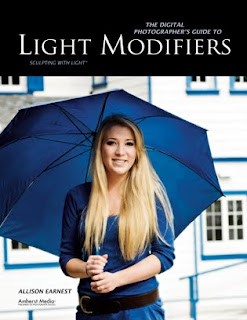 Today's post comes from the The Digital Photographer's guide to Light Modifiers: Sculpting with Light by Allison Earnest. It is available from Amazon.com and other fine retailers.
Today's post comes from the The Digital Photographer's guide to Light Modifiers: Sculpting with Light by Allison Earnest. It is available from Amazon.com and other fine retailers.Using your studio lights outside is the same as inside—with one exception: you must determine your shutter speed for the desired background (ambient light) exposure. When shooting with a combination of flash and ambient light, your shutter speed controls the available-light exposure (the exposure of everything not lit by the flash), while your aperture controls the the flash exposure (in most cases, this is the exposure of your subject). Yes, it takes much more effort and
courage to use your studio lights outdoors, but the final images you show your clients will be worth the effort.
Ballerina Rhiona O’Laughlin was the perfect subject for this outdoor studio portrait (PHOTOGRAPH 1). Once the location, wardrobe, and props were selected, a wonderful team of helpers started setting up lights—while trying to stay warm. The main light used on this image was a ring flash on axis with the camera. This was metered to record one stop brighter than the background. A simple monolight fitted with barndoors was used as the accent/hair light. This was powered to record one stop brighter than the main light. The barn doors were useful to help block unnecessary light on the scene.
 PHOTOGRAPH 1. An incident-light meter reading taken of the ambient light determined my shutter speed. My flash was metered to determine the aperture, which controlled the exposure desired on my model. SUBJECT: Rhiona O’Laughlin. CAMERA: Nikon D300, Lexar media. SETTINGS: AWB, manual mode, 1/80 second, f/7, ISO 200.
PHOTOGRAPH 1. An incident-light meter reading taken of the ambient light determined my shutter speed. My flash was metered to determine the aperture, which controlled the exposure desired on my model. SUBJECT: Rhiona O’Laughlin. CAMERA: Nikon D300, Lexar media. SETTINGS: AWB, manual mode, 1/80 second, f/7, ISO 200. In photograph 2, the main light was changed to a medium softbox. This was positioned at a 45-degree angle to the subject, producing a soft lighting pattern on Rhiona’s face. A warming gel was placed over the accent/hair light to closely match the warmth of the late afternoon sun. My shutter speed was lowered to record more of the ambient light in the scene.
 PHOTOGRAPH 2. My shutter speed was lowered to record more ambient light in the scene, and the main light was slightly underexposed. SUBJECT: Rhiona O’Laughlin. CAMERA: Nikon D300, Lexar media. SETTINGS: AWB, manual mode, 1/40 second, f/10, ISO 200.
PHOTOGRAPH 2. My shutter speed was lowered to record more ambient light in the scene, and the main light was slightly underexposed. SUBJECT: Rhiona O’Laughlin. CAMERA: Nikon D300, Lexar media. SETTINGS: AWB, manual mode, 1/40 second, f/10, ISO 200. With the same softbox, the light was remetered after Rhiona changed poses (below). Here’s a bit of advice: when shooting on location, always bring a small wood board for your model to stand on when posing. I didn’t have one for this shoot, and the young lady accidentally stepped on a hidden cactus. As a true professional dancer, Rhiona continued to pose and smile—despite the cactus and the very chilly Colorado weather. It definitely takes a great team to create great photographs.



No comments:
Post a Comment